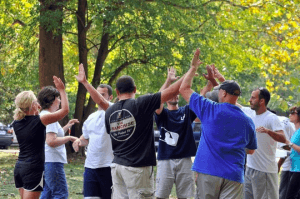The surprising power of high fives, fist bumps and physical contact among teams.
Even if you don’t know much about American football, there’s nothing quite like sitting up in the bleachers during the months of fall, cheering on a favorite team. The air is crisp, and there’s a certain feeling that comes with wearing team colors and the camaraderie of the crowd.
So when I recently got the chance to go see a University of Michigan home game in Ann Arbor … well, I couldn’t resist. While I have attended plenty of football games in my life, this was my first time in a large university stadium. It was incredibly exciting, and the enthusiasm of loyal fans was contagious, to say the least.
But while my friends kept close track of first downs and flags-on-the-play, I paid closer attention to the behavior of the players. Specifically, I studied their body language:
- Were they high-fiving?
- Were they fist- and chest-bumping?
- How were they performing?
Respect the high-five. <– Click to Tweet
There is a specific reason why my attention was drawn to hand gestures instead of touchdowns, and it has nothing to do with team spirit. As a coach and facilitator, I know how powerful such interactions can be. So powerful, that the act of high-fiving even has its very own holiday: National High Five Day (it’s the third Thursday of April – mark it down in your calendar).
Studies continue to show the importance of physical touch (also known as tactile communication), in situations that involve teamwork. In fact, fist bumps and shoulder slams help promote cooperation, and can reflect a higher level of trust and warmth among groups.
Research has also revealed a direct correlation between the level of physical touch among teammates and their collective level of success. In other words, the higher the frequency of tactile communication among players, the higher they rate in various measures of performance.
It’s not just for athletes.
But physical touch doesn’t just benefit athletic teams; the importance of tactile communication among co-workers and colleagues can’t be overemphasized.
High-fives and similar connections actually help reduce stress because they set off the release of oxytocin, a hormone that helps create a sensation of trust. They also help reduce levels of cortisol, the stress hormone. As it was explained in a New York Times online article:
In the brain, prefrontal areas, which help regulate emotion, can relax, freeing them for another of their primary purposes: problem solving. In effect, the body interprets a supportive touch as “I’ll share the load.”
Let’s go, team!
The power of personal touch can transform ordinary groups and organizations into extraordinary ones, and improve team productivity and cohesiveness. That’s why, just as I paid special attention to the players on the sidelines during the Michigan game, I also continuously observe the group behavior of my clients.
Are they high-fiving, fist-bumping and using tactile communication with each other during team-building activities? If the answer is yes, then I know the group is going to work well with each other. If the answer is no, then I know there’s more work to be done.
Go ahead – give me five! <– Click to Tweet
So what do you think – is tactile communication an important element for your group or organizations? Have you been a part of a team that uses it (or doesn’t)? I’d love to hear about your experiences – just leave your comments below.
